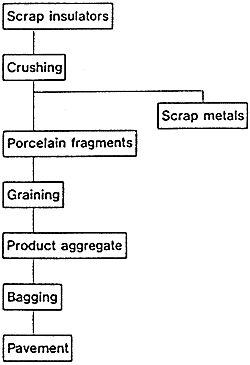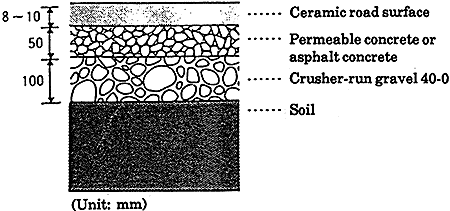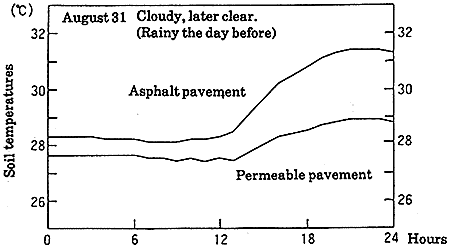Waste Treatment Technology in JAPAN
Recycling
Commercially available ceramics aggregate is used in colored permeable pavement. Such products are expensive. It is anticipated, however, that the pavement market will expand because permeable pavement material is useful for: (1) alleviating the so-called "heat island" phenomenon, (2) lessening the load on sewage treatment plants, and (3) improving the rhizosphere and environment for vegetation.
(1) Crushing porcelain-insulators
Fig. 1 Steps in Manufacture of Ceramics Aggregate
(2) Determining optimum resin percentage
(3) Experimental paving
Fig. 2 Structure of Permeable Pavement (Cross-section)
This permeable pavement was tested and compared with asphalt pavement to assess its effectiveness in moderating the heat island phenomenon.
Fig. 3 Measurements of Heat Island Phenomena (Examples)
On the morning that measurement took place, soil temperatures slightly differed depending on types of pavement because it rained the day before. In the afternoon, however, the weather was clear, and therefore, a greater soil temperature difference was observed between asphalt and permeable pavements. Even during the night, no significant change in soil temperature was observed. This observation suggested that the experimental pavement can moderate the heat island phenomenon.
1. Overview
From power transmission and distribution systems, scrap white porcelain-insulators were collected. These insulators have a high degree of hardness, and low water absorbability. A study was conducted in the use of crushed porcelain as a ceramics aggregate.

2. Description of Development
Attempts were made to develop permeable pavement material that contains crushed porcelain (grain size: 0.5-3.0 mm) as aggregate, and epoxy resin adhesive for solidification. The ability of rain-water to penetrate through the aggregate is a special feature.
Conventional methods of crushing hard porcelain-insulators produce sharp fractured fragments that resemble broken pieces of glassware. The newly developed method uses a granulating machine that forces crushed pieces to collide with each other thereby forming grains. Fig. 1 shows steps in the manufacture of the ceramics aggregate.

Strength and permeability of the pavement are determined by the percentage of resin that maintains point adhesion of aggregate materials. Several samples were produced of varying resin percentages. The samples were tested and according to the results, the resin percentage of 7.5%, by weight, was selected as the standard specification.
As shown by the cross-section in Fig. 3, the surface layer of permeable pavement material made from porcelain-insulators is bonded onto an underlying layer of permeable concrete or asphalt in order to reduce the use of expensive epoxy resin.


11-20 Nakoji 3-chome, Amagasaki, Hyogo 661-0974, Japan
Telephone: (06)491-0221
Facsimile: (06)498-7662